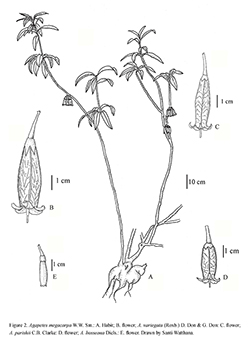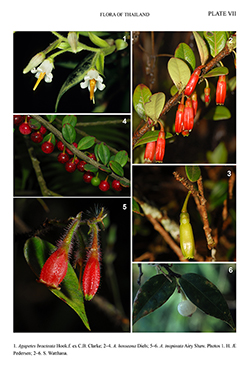e-Flora of Thailand
Volume 13 > Part 1 > Year 2015 > Page 103 > Ericaceae > Agapetes
2. Agapetes hosseana Dielswfo-0000523044
Repert. Spec. Nov. Regni Veg. 1: 16. 1905; Craib, Bull. Misc. Inform. Kew 1911: 404. 1911; Dop, Fl. Indo-Chine [P.H. Lecomte et al.] 3: 700 Fig. 80. 1930; H.R.Fletcher, Fl. Siam. 2: 311. 1938; Airy Shaw, Kew Bull. 13: 505. 1959; Sleumer, Dansk Bot. Ark. 23(1): 79. 1963; Watthana, Thai J. Bot. 4(1): 102, fig. 1B–D. 2012. Fig. 2E; Plate VII: 2–4.
Accepted Name : This is currently accepted.
Description : Epiphytic or terrestrial shrub to 1 m tall; with woody tubers; branches with dark brown setose hairs, rarely glabrous and shiny. Leaves spiral; oblanceolate, obovate, oblanceolate-oblong to elliptic; 1.7–3.5 by 0.6–2 cm; coriaceous, glabrous on both surfaces; base cuneate; margin entire and revolute, with 1–2 pairs of glands at the base; apex retuse, obtuse to mucronate; midrib distinctly prominent above near the base, prominent and thick beneath; veins 6–9 on each side of midrib, distinct above, obscure beneath; petiole 1–3 by 1–2 mm, glabrous, flattened above. Flowers bright red, orange-red or light green, solitary or fasciculate with 2–4 flowers; bracts attached at the base of the pedicel, broadly triangular, ca 0.5 by ca 0.7 mm, hairy and ciliate; pedicels 10–18 mm long, glabrous, thickened at the apex, articulate at both ends. Calyx tube 2–2.5 by 2–3 mm (ca 1.5 by 1.5 mm when dry), hairy to subglabrous; calyx limb campanulate, 2.5–3 mm long, divided to 1/3–1/2 of its length; calyx lobes shortly triangular, ca 1 mm long, apex acute; hairy outside, glabrous inside. Corolla tubular, 15–23 by 3–5 mm, with 5 longitudinal ridges, glabrous on both surfaces; tube 4–22 mm long; lobes triangular, ca 1 by 1.5–1.8 mm. Filaments flattened, white; 7–10 by 0.4–0.7 mm, sparsely hairy to almost glabrous; anthers 3–4 mm long; tubules 2.5–4 mm long, with 2 spurs, 1–2 mm long, dimorphic; opening by elongate pores. Disc glabrous. Styles 14–24 mm long, glabrous; stigma truncate. Fruits globose, 8–10 mm in diam. Seeds numerous, oblong-linear, 1.8–2 by 0.8–0.9 mm.
Thailand : NORTHERN: Mae Hong Son (Khun Yuam, Doi Khun Huai Pong), Chiang Mai (Doi Chiang Dao, Doi Suthep-Pui, Doi Inthanon, Doi Mon Chong, Chom Thong); NORTH-EASTERN: Loei (Phu Luang); SOUTH-EASTERN: Prachin Buri (Khao Yai), Chanthaburi (Khao Soi Dao).
Distribution : South Myanmar and Laos.
Ecology : Epiphytic shrub on tree branches in evergreen forests or terrestrial shrub on rocks on limestone hills, or on the ground in open areas at high altitudes, 1,250–2,500 m.
Vernacular : Saphao lom (สะเภาลม)(Central).
Notes: Agapetes hosseana is very similar to A. mannii Hemsl., but it differs from A. mannii by usually having setose hairs on the young branches and red or orange flowers while A. mannii is only pubescent on the young branches with mostly green flowers rarely red. Recent field studies reveal that there are green flowered populations of A. hosseana from lower northern (Phitsanulok: Phuhin Rongkla), northeastern (Loei: Phu Luang) and southeastern (Prachin Buri: Khao Yai and Chanthaburi: Khao Soi Dao) Thailand. They are considered to be just a colour form. A few plants in the Khao Soi Dao population have shiny glabrous branches. However, they are still treated as separate from A. mannii Hemsl., due to lack of pubescence on the branches and the relatively larger leaves (usually more than 1.5 cm long). Moreover, specimens from Mae Taman, Chiang Mai Province, (Watthana 1229, 1230 -QBG), show variation in hairiness with few setose hairs and shiny young branches. These shiny specimens are still considered to be part of the A. hosseana entity.


